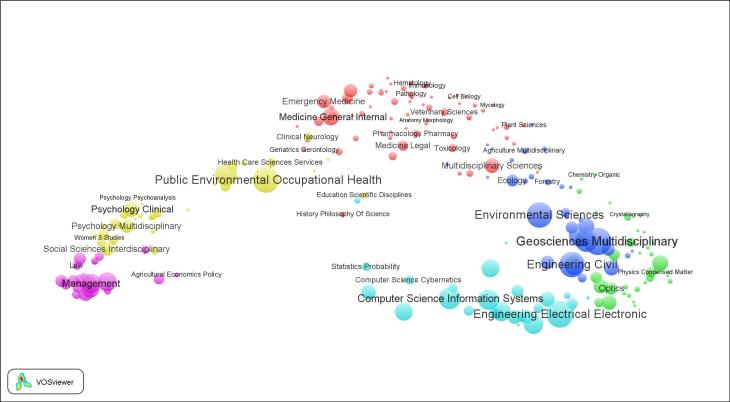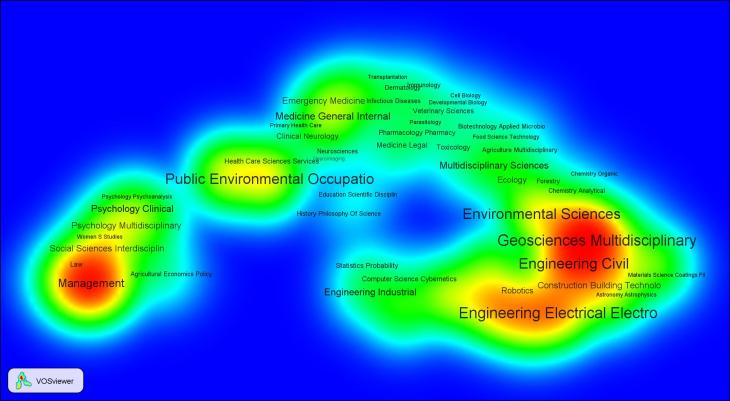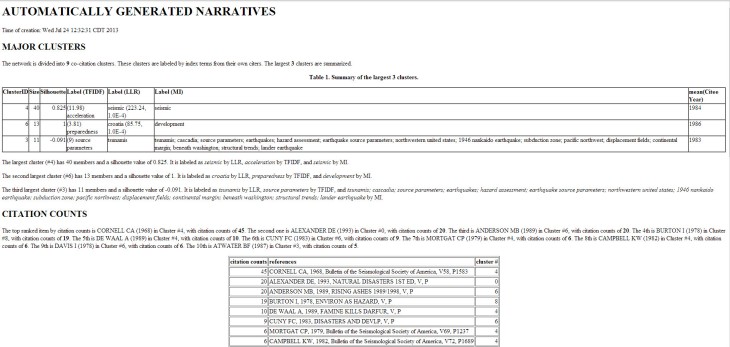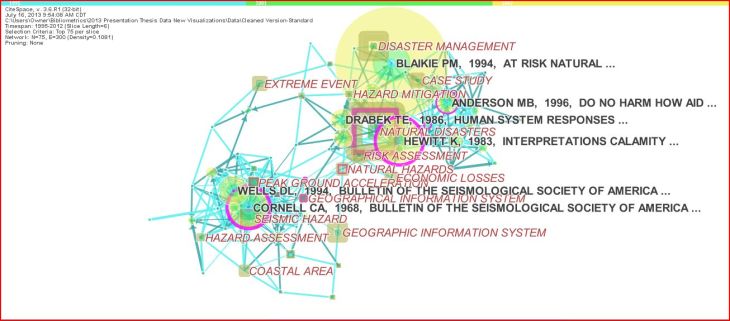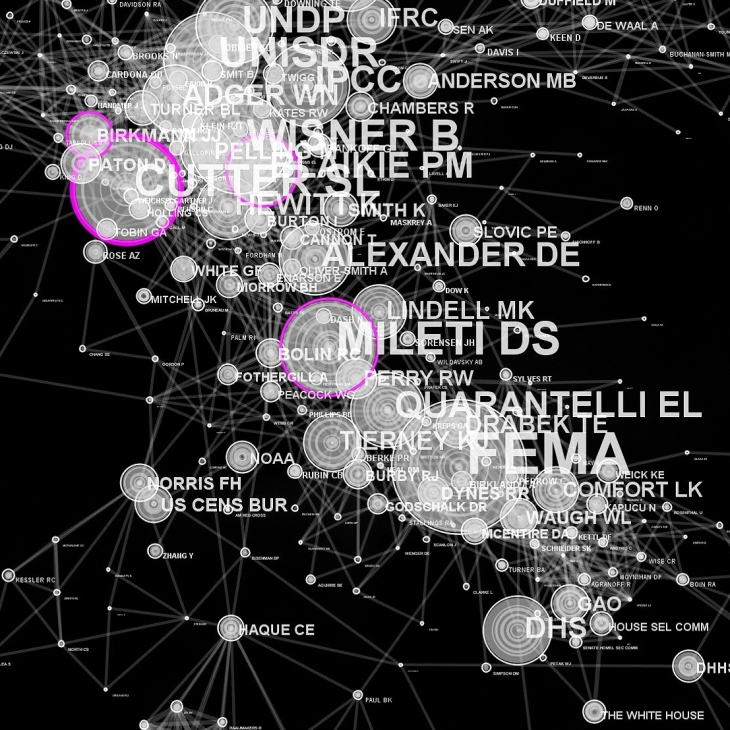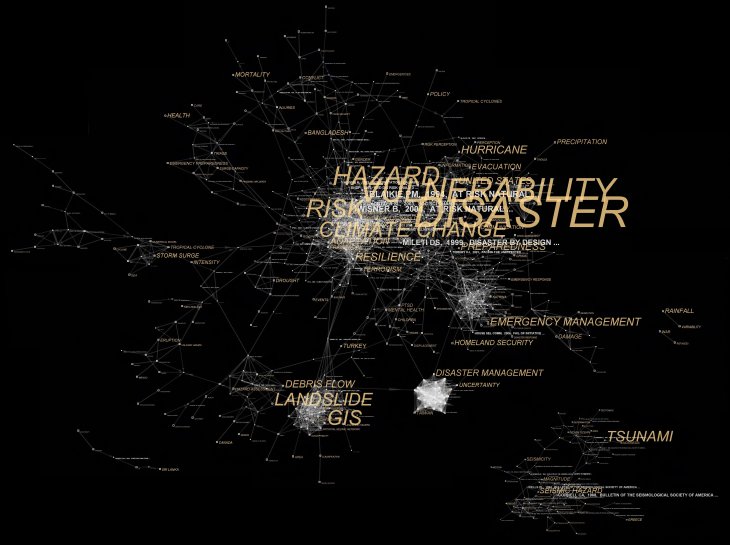Home » Emergency and Disaster Management » Disciplinary Status
Category Archives: Disciplinary Status
How I Gave Myself a Headache Considering the Disciplinarity of Disaster Studies and Sciences….
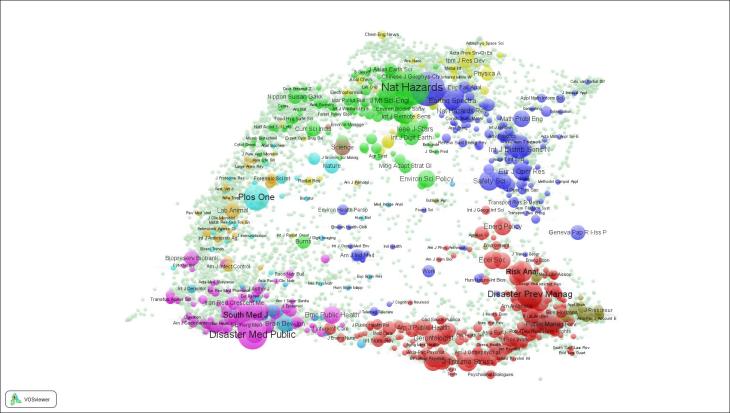
Disasters Across the Disciplines: Preliminary overlay map showing the source journals for over 5000 disaster and hazard-related articles published in 2013 and indexed in Web of Science. These journals are overlaid upon Leydesdorff et al.’s (2013) basemap of science using 2011 citing patterns between journals.

Density, or “heat” map, of the same data, showing the journal areas most active in Disaster Studies and Sciences in 2013.
The great physicist Niels Bohr once said something to the effect that anyone who didn’t come away from reading about quantum mechanics with their head spinning probably hadn’t understood it properly. I have found that, in addition to quantum mechanics, any significant time spent thinking about the nature of disciplines and how best to describe Disaster Studies and Sciences in terms of disciplinarity, also tends to make my head spin.
There is at the moment no shortage of descriptors for disciplinarity: unidisciplinary, multidisciplinary, interdisciplinary, crossdisciplinary, metadisciplinary, hyperdisciplinary, superdisciplinary, supradisciplinary, and transdisciplinary can all be found in the literature. Despite the multitude of terms, no clear, consistent, and agreed typology currently exists. So one has an veritable ocean of ideas within which to swim about. Or drown in.
Of course, there is much that is historical, sociological, political, economic, and just flat out arbitrary in the development of academic and professional “disciplines.” The quest for knowledge using systematic methods predates any attempts to make the pursuit of that knowledge the primary domain of particular individuals. So to some extent in trying to develop a logical, coherent conception of academic, scientific, and professional disciplines, we are trying to logically explain what was originally created without logic, or “big picture” in mind.
This does not mean that the concept of disciplines is of no value. It means that a degree of fuzziness and inconsistency in our concepts should be expected.
In my thesis, I assert that based upon the existence and structure of its body of knowledge, what is often referred to as “Emergency Management” involves far more disciplines than recognized. I suggest that this field/discipline is more accurately called Disaster Studies and Sciences (DSS). I am beginning to see, however, that simply calling DSS a “discipline” is more problematic. DSS is certainly not unidisciplinary and does not fit within any traditional disciplinary map of knowledge, yet it does have an organized structure. There can be no doubt that DSS is multidisciplinary but it does not appear to transcend its individual disciplines to the level of an interdiscipline or transdiscipline….
And this is the point where my head starts to hurt and I begin to think that some part of the puzzle is just out of reach…..
DCA 1995-2013: 1996

Continued evolution and cluster consolidation is evident in 1996’s 100 most cited, particularly in the areas of seismic hazard analysis/engineering, and disasters/development. Some well-known authors and works also make their appearance in the 1996 network (click image to enlarge).
CiteSpace-generated cluster summary and network narrative:
Citation Bursts:
For 1996, we have for the first time some nodes that stand out in the visualization, relative to the others: Ian Burton’s classic work Environment as Hazard (Environmental Science/Human Ecology); CA Cornell (seismic engineering/hazard assessment); MB Anderson, FC Cuny, and A De Waal (disasters and development); and DE Alexander’s classic 1993 work that is now part of a small Geography and Hazard cluster.. In addition to the the large seismic hazard cluster, a volcanic hazard, and tsunami hazard cluster has emerged. What is interesting about the volcanic co-citation cluster is that this is where Burton’s work makes its first appearance. LK Comfort’s 1988 work on managing disasters also appears in a cluster this year.
Still, no between-cluster links have emerged…according to Chen, works that are considered “turning points” often link different clusters together, particularly when links are established across periods of time. Perhaps in later years we will see some works emerge among the 100 most cited that link different clusters together. This would be indicated by a document node between clusters that has high centrality.
Also, notice that there is quite a delay between the year of publication, year of first citation (1996), and the “burst” years for Burton, Cornell, and Anderson. It appears as if their works will not be taken up by many writers for nearly 10 more years.
What will 1997 look like?…
Time Slicing in CiteSpace
I was asked during my presentation yesterday whether it is possible to break down a time span into increments. CiteSpace can indeed break down any time span into increments of one year or more and visualize the network for each slice in one go…though your processor may start to feel the strain, for example, as it tries to crank out a 20 year time period in 10, 2-year slices. You can also chose to simply look at a single year in a one-year slice.
A couple of Document-Term network examples from my presentation data that I generated last night using the latest version of CiteSpace, which came out just earlier this month:
Natural Hazards Workshop Presentation-New Visualizations
I am in the middle of final preparations to leave for the Natural Hazards Workshop in Colorado tomorrow, where I will be making my first post-Master’s presentation of my research work. I will be part of a “New Researchers” session on Monday. I am a little nervous.
For the presentation I have created a new set of visualizations of Disaster Studies and Sciences, as well as prepared a supplemental handout, as 8 minutes is not a lot of time to present a topic that most will never have heard of before. Power Point presentations are discouraged at the Workshop, but they have made an exception for me because of the inherently visual nature of the work.
I have updated the thesis dataset to include articles from all of 2012 and some of 2013. Here are some of the new images I will be showing:
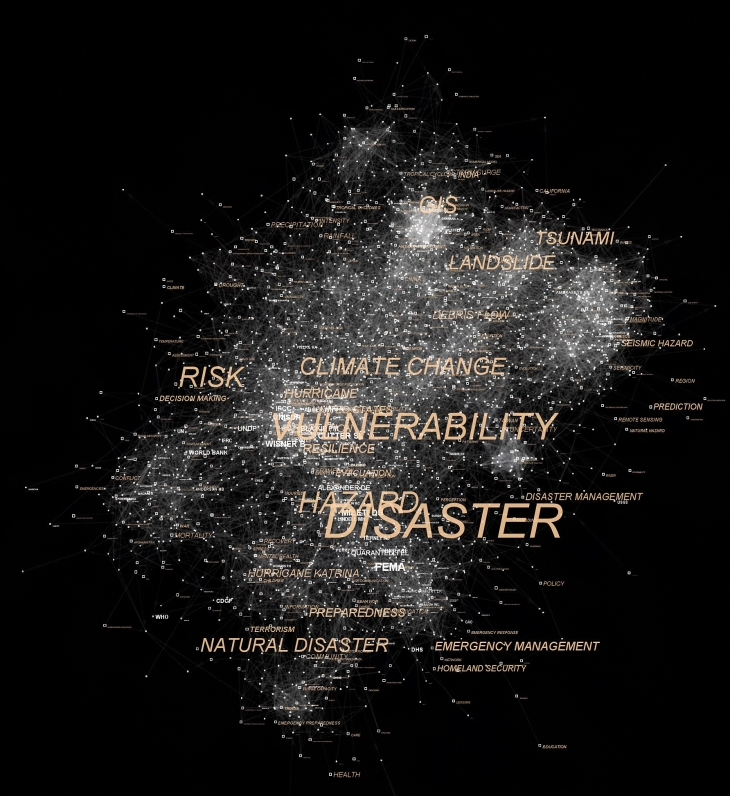
A 3000 node Author-Term/Keyword network….looks remarkably like a galactic nebula, or an aerial photo of a city at night…and can be interpreted similarly…brighter areas indicate areas of greater activity.
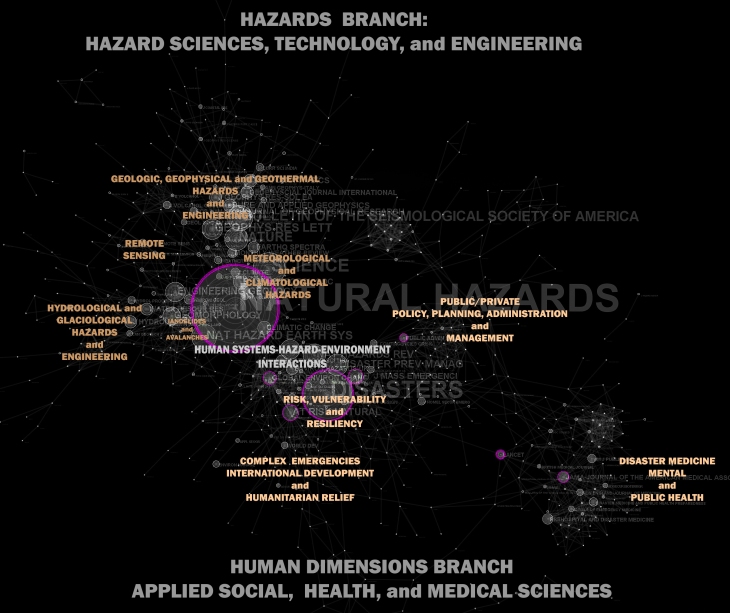
The general organization of the discipline remains basically the same as observed in the thesis visualizations….
If You Meet a Government Agency on the Road to Professionalization…
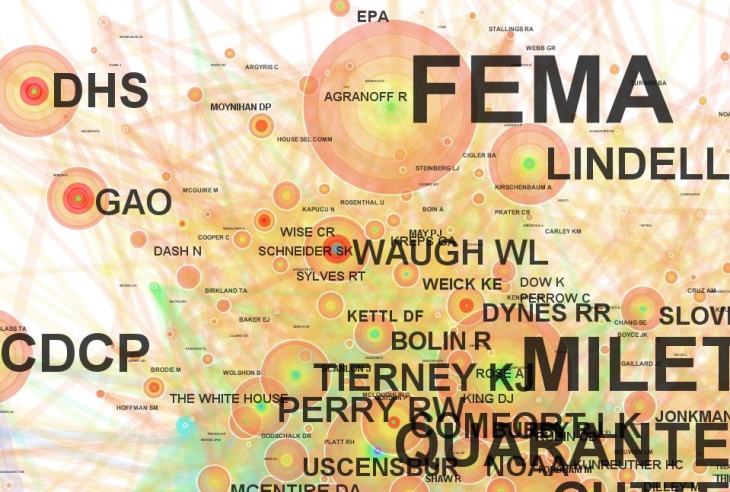
Within the emergency management section of the Author Co-citation Analysis network presented in my thesis, government agencies are quite prominent and received a large number of citations from 1994-2011. The significant presence of government in literature citation networks can raise questions about the level of influence it may exert on a field of study.
The blog title alludes to one of the classic koans of Zen Buddhism: “If you meet the Buddha on the road you must kill him.”
First, let me make clear: I am not advocating violence, and I have nothing against the Buddha. Secondly, let me also point out, for reasons that will soon become apparent: I love FEMA, and believe it has done, and continues to do, much to support and further the field of emergency management in our country. I hope anyone from FEMA who might be reading this will keep that in mind, especially should I apply for a grant someday…. I have used this particular koan because, in my mind, its sentiment is appropriate for a discussion of the relationship between FEMA and emergency management in the U.S., particularly in regards to EM’s dream of one day growing up from an occupation into a profession.
In my interpretation of the Zen saying (which I don’t claim is necessarily the right one, or the best), to reach the ultimate goal you must find your own identity, and follow your own path. You must find your independence. On the road to professionalization, EM has met FEMA on the road. Rather than kill it, EM appears to have decided to hitch a ride in FEMA’s car. You may disagree that EM is too dependent upon FEMA for support and direction. Perhaps I am being rather harsh. About six months ago I probably would have agreed, as I had not given much thought to the relationship of EM and FEMA, and its effect upon professionalization. This changed when I started research into the EM body of knowledge and made a startling discovery. If you open the study guide for IAEM’s certification exam, page 4 provides some study advice:
“”‘Brush up’ on basic emergency management
literature.
A listing of publications from which all exam
questions were derived is included on the
back of this brochure.”
Turning to pages 16-17 (for the U.S. version), I found that the list was composed entirely of FEMA online courses and a couple of pieces of key legislation. No books. No journal articles. No conference papers. No government reports (e.g. A Failure of Initiative). Even though we now have undergraduate and graduate programs in EM, it appears that all you really need to know of professional EM is contained in the FEMA independent study catalog.
This is just one example of how intertwined EM and FEMA have become, but there are many other examples, and it is not limited to FEMA.
Is this a problem? If EM wants to become a profession then it might be. An important characteristic of professions many writers have identified is autonomy. (Cwiak 2009b). At the top of the professional pyramid, fields like law, medicine, and more recently clinical psychology, have unparalleled autonomy and independence in deciding the requirements and standards for admittance, education, training, practice, license, ethics, and discipline. Their practitioners exercise independent judgement that is expected to be based on the current state of knowledge, and to be in the best interests of those that depend on their services. What do these professions (and many others) also have?: strong national associations (AMA, Bar Association, and APA) to govern and advance their professions. They do not need the Department of Health and Human Services, or the Department of Justice to help them in matters that pertain to their professions. Professions are supposed to shape themselves-they don’t ask for the government’s help. When necessary, professions, through their associations, will actively oppose the proposed actions of government.
EM in the U.S. has two main national associations. Yet it is the unofficial third association-FEMA, that to my own untrained eye, seems to play a greater role in promoting and advancing the development of the occupation (including endorsing and providing EM-related educational materials for use in colleges and universities) than either of the other two. But government has its own interests and agendas. Even when provided with the best of intentions, an agency’s “helpfulness” (particularly when that agency is a provider of important resources, grant funding, and employment to those it is helping…) can bring risks to objectivity, expression of alternative viewpoints, independence, and credibility. EM in the U.S., because of its history, evolutionary path, and nature of its work, has already developed a high affinity for seeing things through the eyes of civil service, public safety, and government. The significant involvement of government agencies in the development of the field may serve to reinforce some of these tendencies to the expense of growth, evolution, and innovation.
This makes me very uneasy, but maybe it is just me seeing things that aren’t there. I hope so.
